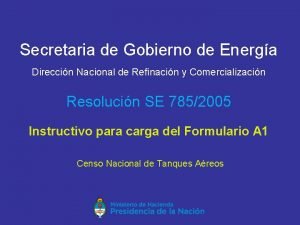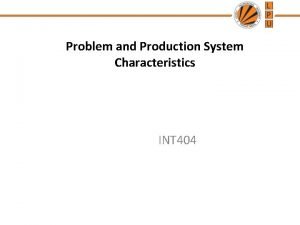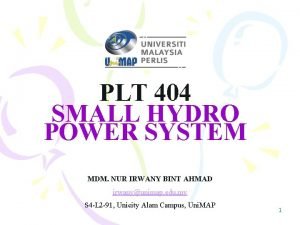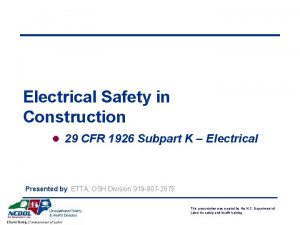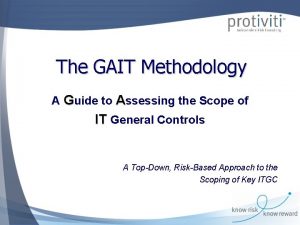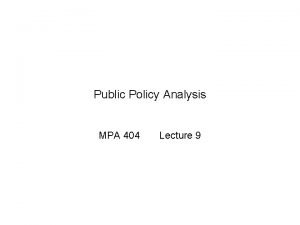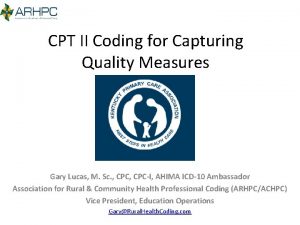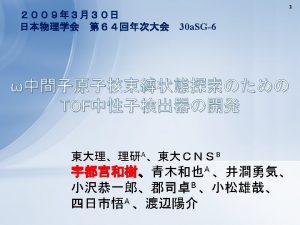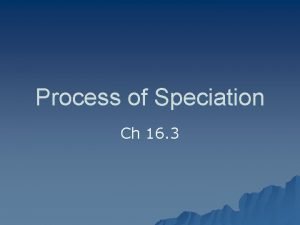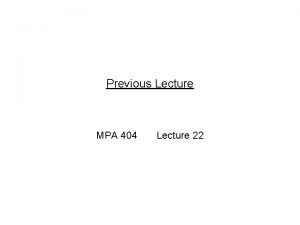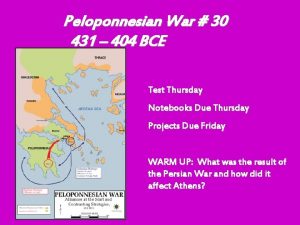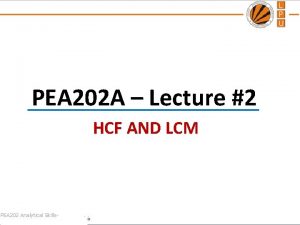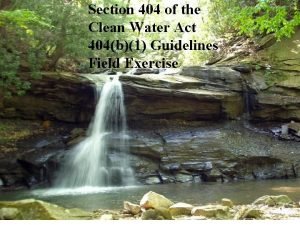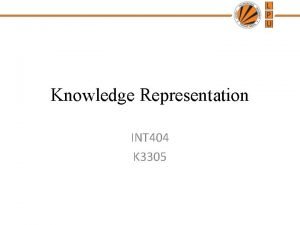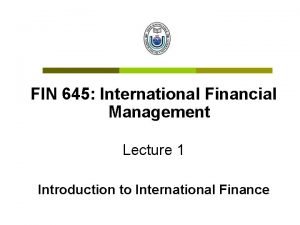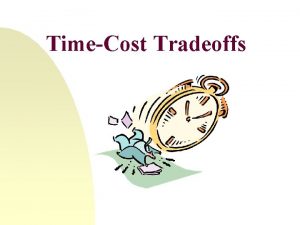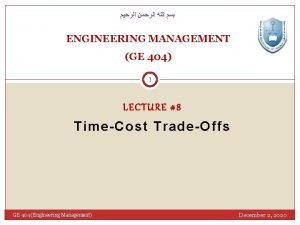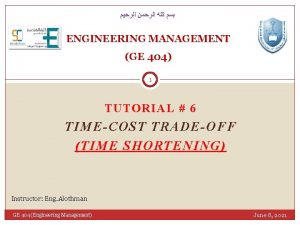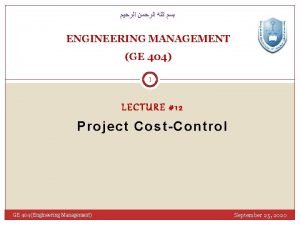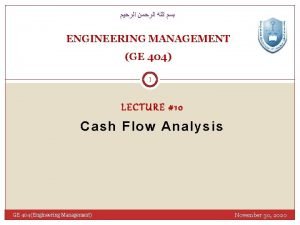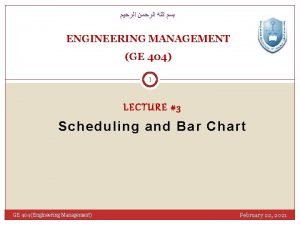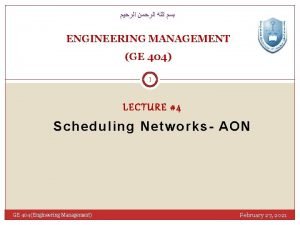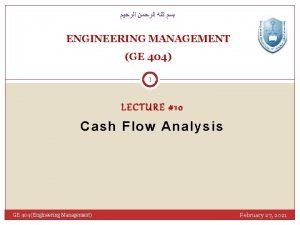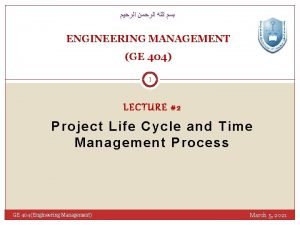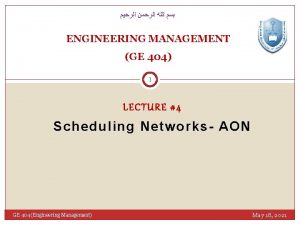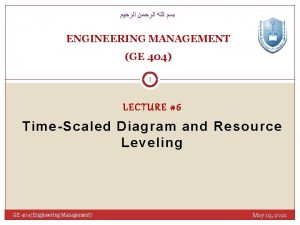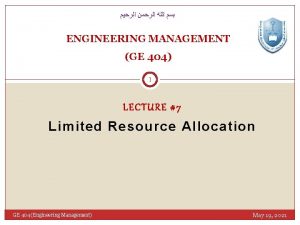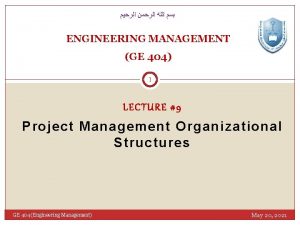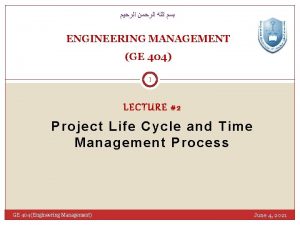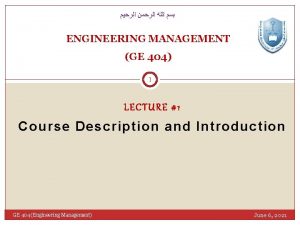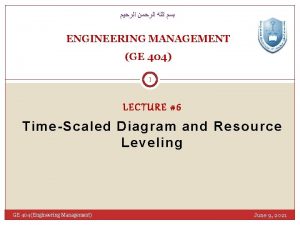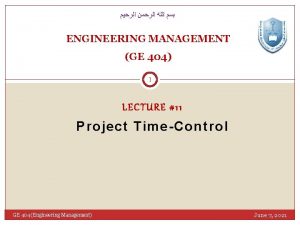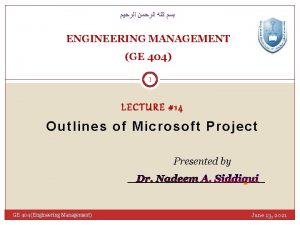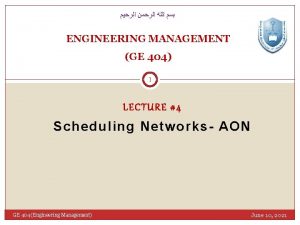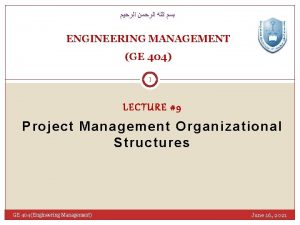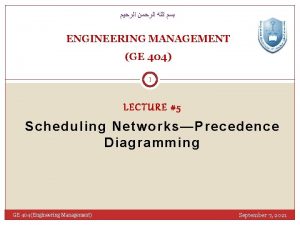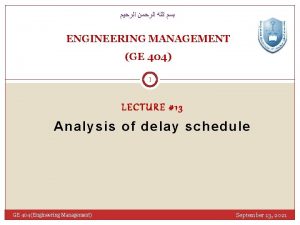ENGINEERING MANAGEMENT GE 404 1 LECTURE 8 TimeCost




































- Slides: 36

ﺑﺴﻢ ﺍﻟﻠﻪ ﺍﻟﺮﺣﻤﻦ ﺍﻟﺮﺣﻴﻢ ENGINEERING MANAGEMENT (GE 404) 1 LECTURE #8 Time-Cost Trade-Offs GE 404 (Engineering Management) February 27, 2021

Contents 2 � Objectives of the present lecture � Time-Cost Trade-offs � Reasons to reduce project duration � Methods to reduce project duration � Types of Costs and project time-cost relationship � Project crashing and cost slope � Compression or Crashing the project schedule � Basic steps in project crashing � Network interaction limit (Nil) � Network compression algorithm � Problem � Further reading GE 404 (Engineering Management) February 27, 2021

Objectives of the Present lecture 3 �To discuss project time-cost relationship �To explain the steps involved in project crashing GE 404 (Engineering Management) February 27, 2021

Time-Cost Trade-offs (Time-Cost Relationship) 4 �There is a relationship between a project’s time to completion and its cost. �By understanding the time-cost relationship, one is better able to predict the impact of a schedule change on project cost. �Time-cost trade-off, in fact, is an important management tool for overcoming one of the critical path method limitations of being unable to bring the project schedule to a specified duration. GE 404 (Engineering Management) February 27, 2021

Reasons to Reduce Project Durations 5 �To avoid late penalties �To realize incentives for timely or early competition of a project �To beat the competition to the market (influences Bid price) �To free resources for use on other projects �To reduce the indirect costs �To complete a project when weather conditions make it less expensive GE 404 (Engineering Management) February 27, 2021

Methods to reduce Durations 6 1. Overtime: Have the existing crew work overtime. This increase the labor costs due to increase pay rate and decrease productivity. 2. Hiring and/or Subcontracting: 3. a) Bring in additional workers to enlarge crew size. This increases labor costs due to overcrowding and poor learning curve. b) Add subcontracted labor to the activity. This almost always increases the cost of an activity unless the subcontracted labor is far more efficient. Use of advanced technology: Use better/more advanced equipment. This will usually increase costs due to rental and transport fees. If labor costs (per unit) are reduced, this could reduce costs. GE 404 (Engineering Management) February 27, 2021

Types of Costs 7 � Direct Costs Direct costs are those directly associated with project activities such as cost of labor, equipment and materials, salaries. If the duration of activities is decreased in order to decrease project completion time, the direct cost generally increase since more resources must be allocated to accelerate the activity. � Indirect Costs Indirect costs are those overhead costs that are not directly associated with specific project activities such as office space, administrative staff, and taxes. Such costs tend to be relatively steady per unit time over the life of the project. Total indirect costs increase as the project duration increases. � Note: Project cost is the sum of the direct and indirect costs. GE 404 (Engineering Management) February 27, 2021

Project Time-Cost Relationship 8 Note: It should never be assumed that the quantity of resources deployed and the task duration are inversely related. Thus one should never automatically assume that the work that can be done by one man in 16 weeks can actually be done by 16 men in one week. GE 404 (Engineering Management) February 27, 2021

Project Crashing and Cost Slope 9 � Shortening the duration of a project is � � � called project crashing The minimum possible duration of an activity (which implies maximum cost) is called the Crashed duration and corresponding cost is called Crashed cost Thus the crash time is the shortest time in which an activity can be completed Duration of an activity which implies minimum direct cost is called the normal duration and corresponding cost is called normal cost The slope of the line connecting the normal point (lower point) and the crash point (upper point) is called the cost slope of the activity. The slope of this line can be calculated mathematically by knowing the coordinates of the normal and crash points. GE 404 (Engineering Management) February 27, 2021

Problem-1 10 Activity Cost Calculate the Crash cost/ week for the shown linear time-cost trade-off for an activity. Crash $34, 000 — $33, 000 — Crash Cost, Cd $32, 000 — $31, 000 — $30, 000 — Normal Cost, CD Normal — GE 404 (Engineering Management) | 1 Crash Time, d | 2 | 3 Normal Time, D Time (Weeks) February 27, 2021

Solution 11 GE 404 (Engineering Management) February 27, 2021

Compressing or Crashing the Project-Schedule 12 �Compressing or Crashing the project schedule refers to the acceleration of the project activities in order to complete the project sooner. �The time required to complete a project is determined by the critical path, so to compress a project schedule one must focus on critical path activities. GE 404 (Engineering Management) February 27, 2021

Basic Steps in Project Crashing 13 1. 2. 3. 4. 5. 6. Compute the crash cost per time period Using current activity times, find the critical path and identify the critical activities If there is only one critical path, then select the activity on this critical path that (a) can still be crashed, and (b) has the smallest crash cost period. If there is more than one critical path, then select one activity from each critical path such that (a) each selected activity can still be crashed, and (b) the total crash cost of all selected activities is the smallest. Note that the same activity may be common to more than one critical path. Update all activity times. If the desired due date has been reached, stop. If not, return to Step 2. GE 404 (Engineering Management) February 27, 2021

Problem-2 For the small project shown in the table, it is required reduce the project duration by (i) 2 periods. (ii) 5 periods. Activity Precedence Normal Crash Time, day Cost, $ A - 4 210 3 280 B - 8 400 6 560 C A 6 500 4 600 D A 9 540 7 600 E B, C 4 500 1 1100 F C 5 150 4 240 G E 3 150 H D, F 7 600 6 750 Σ GE 404 (Engineering Management) 14 3050 4280 February 27, 2021

Solution Step 1: Develop Network 15 9 D 4 6 5 7 A C F H FINISH START 8 4 3 B E G GE 404 (Engineering Management) February 27, 2021

Step 2: Calculate Times and Find CP 16 9 4 13 D 6 0 4 4 4 A 0 0 0 START 0 0 0 6 2 10 15 10 4 0 10 10 15 0 7 22 H 15 15 0 22 22 0 22 FINISH 0 8 8 10 B 7 • • 15 F C 4 5 7 4 14 14 15 5 19 19 Activity Project completion time = 22 working days Total float Critical Path: A, C, F, H. Free float GE 404 (Engineering Management) 22 17 0 22 G E 15 3 A 0 0 5 22 B C D 7 0 2 2 0 2 E F G H 5 0 0 0 5 0 February 27, 2021

Step 3: Calculate Cost Slope 17 Activity Precedence Time, day Cost, $ Cost Slope, $/day Normal Crash A - 4 210 3 280 70 B - 8 400 6 560 80 C A 6 500 4 600 50 D A 9 540 7 600 30 E B, C 4 500 1 1100 200 F C 5 150 4 240 90 G E 3 150 ** H D, F 7 600 6 750 150 Σ 3050 4280 Note: 1 - G can not expedite 2 - Among the critical activities the lowest slope is for activity C, so it can be expedited on critical path by 2 periods GE 404 (Engineering Management) February 27, 2021

Step 4(a): Reduce 2 periods of activity C Solution-(i) 18 ES LS Activity 9 4 EF 13 0 4 4 4 A 0 0 0 START 0 0 0 4 0 8 13 increase of cost (2× 50) = $100 8 4 0 8 8 13 13 0 7 20 H 13 13 0 20 20 FINISH 0 8 8 8 B Activity Total float Free float 5 F C 4 LF Crash limit (d @ cost) D 4 TF 4 12 12 5 13 A 0 0 B C D 5 0 0 0 GE 404 (Engineering Management) 13 5 15 20 0 20 G E 5 3 17 17 5 20 E F G H 5 0 • Project completion time = 20 working days 0 0 5 0 • Critical Path: A, C, F, H. & A, D, H February 27, 2021

Step 4(b): Reduce 1 period of activity A 19 Increase of cost = $70 9 3 12 D 3 0 3 3 3 A 0 0 0 START 0 0 0 4 0 7 12 7 3 0 7 7 12 0 7 19 H 12 12 0 19 19 0 19 FINISH 0 8 8 7 B 8 • • 12 F C 3 5 4 4 11 11 Project completion time = 19 working days Critical Path: A, C, F, H. & A, D, H GE 404 (Engineering Management) 12 5 14 19 0 19 G E 12 3 16 16 Activity Total float Free float A 0 0 5 19 B C D 4 0 0 0 E F G H 5 0 0 0 5 0 February 27, 2021

Step 4(c): Reduce 1 period of 2 activities (D, F) 20 Increase of cost (30+90) = $120 3 8 11 D 3 0 3 3 3 A 0 0 0 START 0 0 0 4 0 7 11 7 3 0 7 7 11 0 7 18 H 11 11 0 18 18 0 18 FINISH 0 8 8 7 B 3 • • 11 F C 3 4 11 11 Project completion time = 18 working days Critical Path: A, C, F, H. & A, D, H GE 404 (Engineering Management) 11 4 14 18 0 18 G E 11 3 15 15 Activity Total float Free float A 0 0 4 18 B C D 3 0 0 0 E F G H 4 0 0 0 4 0 February 27, 2021

Step 4(d): Reduce 1 period of activity H 21 Increase of cost = $150 3 8 11 D 3 0 3 3 3 A 0 0 0 START 0 0 0 4 0 7 11 7 3 0 11 11 F C 3 4 7 7 0 6 17 H 11 11 0 17 17 0 17 FINISH 0 8 8 7 B 2 2 4 11 11 Ø Project completion time = 17 working days Ø Critical Path: A, C, F, H. & A, D, H GE 404 (Engineering Management) 10 3 17 14 0 17 G E 10 3 14 14 Activity Total float Free float A 0 0 3 17 B C D 2 0 0 0 E F G H 3 0 0 0 3 0 February 27, 2021

Step 5: Solution (ii) 22 Total cost Duration 3050 22 100 3150 20 1 70 3220 19 D, F 1 30+90 3340 18 H 1 150 3490 17 Activity 0 - 1 C 2 2 A 3 4 Cost Cycle Time cost Reduction of project duration from 22 to 17 days increases the cost to $3490. 3550 Activity Precedence 3450 A 3350 3250 3150 3050 2950 16 17 18 19 20 21 Project Duration GE 404 (Engineering Management) 22 23 Normal Crash Cost Slope, Time, day Cost, $ $/day - 4 210 3 280 70 B - 8 400 6 560 80 C A 6 500 4 600 50 D A 9 540 7 600 30 E B, C 4 500 1 1100 200 F C 5 150 4 240 90 G E 3 150 ** H D, F 7 600 6 750 150 Σ 3050 4280 February 27, 2021

Network Interaction Limit (Nil) 23 GE 404 (Engineering Management) February 27, 2021

Network Compression Algorithm 24 1. Determine normal project duration, cost and Critical Path 2. Compute the cost slope and shorten the Critical Activities beginning with the activity having the lowest cost-slope 3. Determine the compression limit (Nil), organize the data in the tabular form and update the project network 4. When a new Critical path is formed: 1. Shorten the combination of activity which Falls on both Critical Paths, OR 2. Shorten one activity from each of the critical paths. Use the combined cost of shortening both activities when determining if it is cost effective to shorten the project. 5. At each shortening cycle, compute the new project duration and project cost 6. Continue until no further shortening is possible 7. Tabulate and Plot the Indirect project Cost on the same time-cost graph; and add direct and indirect cost to find the project cost at each duration 8. Use the total project cost-time curve to find the optimum time GE 404 (Engineering Management) February 27, 2021

Note 25 For large network, use criticality theorem to eliminate the noncritical paths that do not need to be crashed. Eliminate Activities with having TF > the required project reduction time. GE 404 (Engineering Management) February 27, 2021

Problem-3 26 The durations and direct costs for each activity in the network of a small construction contract under both normal and crash conditions are given below. Establish the least cost for expediting the contract. Determine the optimum duration of the contract assuming the indirect cost amounts SR 125/week. 38470 GE 404 (Engineering Management) February 27, 2021

We have one critical path, A-C-G- I. Either crash A at cost SR 100/week or crash C at cost SR 200/week or crash G at cost SR 60/week or crash I at cost SR 75/week. Solution Cycle #1 20 23 43 D 24 4 47 0 0 12 12 A 0 0 12 2@100 12 8 20 B 14 2 22 2@150 20 5 25 E 22 2 27 1@50 27 20 47 G 27 0 47 5@60 12 15 27 C 12 0 27 3@200 27 5 32 F 29 2 34 1@300 32 13 45 H 34 2 47 2@40 Cycle Activity to Can Be Weeks Nil # Shortened 0 1 G 4 5 2 2 47 12 59 I 47 0 59 2@75 2 Cost for per Cycle Week 60 120 ES D EF Activity LS TF LF Crash limit Total Cost Project Duration 36, 500 36, 620 59 57

Now we have two critical paths: A-C-F-H-I and A-C-G- I. Either crash A at cost SR 100/week or crash C at cost SR 200/week or crash I at cost SR 75/week or crash F and G at cost SR 360/week or crash H and G at cost SR 100/week. 0 12 12 A 0 0 12 2@100 Cycle #2 20 23 43 D 22 2 45 0 12 8 20 B 14 2 22 2@150 20 5 25 E 22 2 27 1@50 27 18 45 G 27 0 47 3@60 12 15 27 C 12 0 27 3@200 27 5 32 F 27 0 32 1@300 32 13 45 H 32 0 45 2@40 Cycle Activity to Can Be Weeks Nil # Shortened 0 1 2 G I 2 5 2 2 2 2 Cost per Week 60 75 45 12 57 I 45 0 55 2@75 ES D EF Activity LS TF LF Crash limit Cost for Cycle Total Cost Project Duration 120 150 36, 500 36, 620 36, 770 59 57 55

Cycle #3 20 23 43 D 22 2 45 0 0 12 12 A 0 0 12 2@100 Cycle # 0 1 2 3 2 Now we have two critical paths: A-C-F-H-I and A-C-G- I. Either crash A at cost SR 100/week or crash C at cost SR 200/week or crash F and G at cost SR 360/week or crash H and G at cost SR 100/week. 12 8 20 B 14 2 22 2@150 20 5 25 E 22 2 27 1@50 27 18 45 G 27 0 45 3@60 12 15 27 C 12 0 27 3@200 27 5 32 F 27 0 32 1@300 32 13 45 H 32 0 45 2@40 Activity Cost Can Be Weeks Cost for to Nil per Shortened Cycle Shorten Week G 5 2 2 60 120 I 2 2 75 150 A 2 2 100 200 45 10 55 I 45 0 55 0 ES D EF Activity LS TF LF Crash limit Total Cost Project Duration 36, 500 36, 620 36, 770 36, 970 59 57 55 53

Now we have two critical paths: A-C-F-H-I and A-C-G- I. Either crash C at cost SR 200/week or crash F and G at cost SR 360/week or crash H and G at cost SR 100/week. Cycle #4 18 23 41 D 20 2 43 0 0 10 10 A 0 0 10 8 18 B 12 2 20 2@150 18 5 23 E 20 2 25 1@50 25 18 43 G 25 0 43 3@60 10 15 25 C 10 0 25 3@200 25 5 30 F 25 0 30 1@300 30 13 43 H 30 0 43 2@40 Activity to Can Be Weeks Cycle # Nil Shortened 0 1 2 3 4 G I A H, G 2 5 2 2 2 Cost per Week 60 75 100 60+40 43 10 53 I 43 0 53 0 ES D EF Activity LS TF LF Crash limit Cost for Cycle Total Cost Project Duration 120 150 200 36, 500 36, 620 36, 770 36, 970 37, 170 59 57 55 53 51

Cycle #5 0 10 10 A 0 0 18 23 41 D 18 0 41 0 10 8 18 B 10 0 18 2@150 10 15 25 C 10 0 25 3@200 0 Now we have three critical paths; A-C-F-H-I, A-C-C- I, and A-B-D- I. Either crash C and B at cost SR 350/wk or crash F, G and B at cost SR 510/wk. 18 5 23 E 20 2 25 1@50 25 16 41 G 25 0 41 1@60 25 5 30 F 25 0 30 1@300 30 11 41 H 30 0 41 10 51 I 41 0 51 0 ES D EF Activity LS TF LF Crash limit Activity to Can Be Weeks Cost per Cost for Total Cycle # Nil Shortened Week Cycle Cost 0 36, 500 1 G 5 2 2 60 120 36, 620 2 I 2 2 75 150 36, 770 3 A 2 2 100 200 36, 970 4 G, H 2 2 2 60+40 200 37, 170 5 B, C 2 2 150+200 700 37, 870 Project Duration 59 57 55 53 51 49

Final Results 0 10 10 A 0 0 10 6 16 B 10 0 16 5 21 E 18 2 23 1@50 23 16 39 G 23 0 39 1@60 10 13 23 C 10 0 23 1@200 23 5 28 F 23 0 28 1@300 28 11 39 H 28 0 39 0 Cycle # 0 1 2 3 4 5 16 23 39 D 16 0 39 0 Project Duration 59 57 55 53 51 49 Direct Cost 36500 36620 36770 36970 37170 37870 39 10 49 I 39 0 49 0 Indirect Total Cost 7375 7125 6875 6625 6375 6125 43875 43745 43645 43595 43545 43995 ES D EF Activity LS TF LF Crash limit

Project Optimal Duration 33 GE 404 (Engineering Management) February 27, 2021

Home Work 34 Data on small maintenance project is given as below: On completion, the project will give a return of SR 110/day. Using time-cost trade-off method, how much would you like to compress the project for maximizing the return (ignore the Indirect cost effect)? Show all calculations. Activity Depends Normal Crash on Time Cost A 6 days SR 700 4 days SR 800 B 4 days 400 C 5 days 650 4 days 700 D A 8 days 625 5 days 700 E B 10 days 200 7 days 350 F B 7 days 500 5 days 700 G C 3 days 600 H D, E 6 days 300 5 days 400 I F, G 7 days 350 4 days 425 Hint: If the project is compressed by n days, the return amount will be n*110 and total cost after compressing by n days will be obtained by the routine procedure. That n has to be searched which makes the difference of the above two costs maximum. GE 404 (Engineering Management) February 27, 2021

Further Reading 35 Read more about the Time-Cost Trade-offs from: Jimmie W. Hinze. “Construction Planning and Management, ” Fourth Edition, 2012, Pearson. GE 404 (Engineering Management) February 27, 2021

Thank You 36 GE 404 (Engineering Management) February 27, 2021
 01:640:244 lecture notes - lecture 15: plat, idah, farad
01:640:244 lecture notes - lecture 15: plat, idah, farad Ubc cpsc 404
Ubc cpsc 404 Ingreso al sistema web res. 1102-404 y res. 785
Ingreso al sistema web res. 1102-404 y res. 785 Int 404
Int 404 Plt 404
Plt 404 Hebrew demonstrative pronouns
Hebrew demonstrative pronouns P-401 faa
P-401 faa Osha 1926 subpart k
Osha 1926 subpart k Ece 404
Ece 404 Int404
Int404 Naugalube
Naugalube Sox 404 it general controls matrix
Sox 404 it general controls matrix Jctd
Jctd 404
404 Pcb design presentation
Pcb design presentation Pqrs measure 404
Pqrs measure 404 Bc 404
Bc 404 Section 16-3 the process of speciation
Section 16-3 the process of speciation 404
404 404 bce
404 bce Hcf and lcm problems for class 5 pdf
Hcf and lcm problems for class 5 pdf Em 404
Em 404 Cpsc 404
Cpsc 404 Peloponnesian war
Peloponnesian war 404 b 1 guidelines
404 b 1 guidelines Mapping between facts and representation
Mapping between facts and representation Financial engineering notes
Financial engineering notes Software engineering lecture notes
Software engineering lecture notes Foundation engineering lecture notes
Foundation engineering lecture notes Descriptive ethics
Descriptive ethics Project procurement management lecture notes
Project procurement management lecture notes Strategic management lecture
Strategic management lecture Project management lecture
Project management lecture Project quality management lecture notes
Project quality management lecture notes Financial management lecture
Financial management lecture Public sector accounting lecture notes in kenya
Public sector accounting lecture notes in kenya Om 306
Om 306


